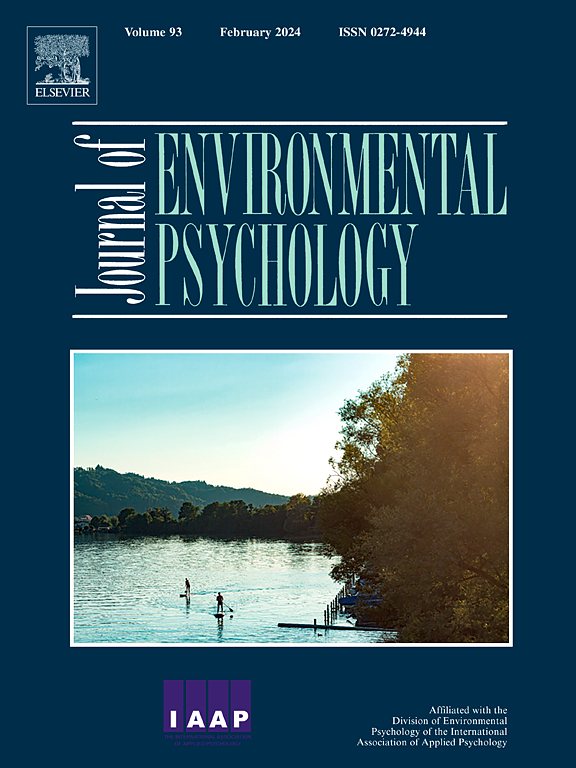自然连通性对中国小学生人际关系和心理健康的纵向影响
IF 7
1区 心理学
Q1 ENVIRONMENTAL STUDIES
引用次数: 0
摘要
自然连通性是一种重要的心理结构,反映了个人与自然环境的情感和认知联系,与儿童的社会和心理健康有关。然而,对其发展轨迹和不同影响的纵向研究仍然很少,特别是在非西方国家。本纵向研究(N = 357名中国小学生;192名女孩(T1平均年龄= 10.44±0.52岁)采用潜在增长模型研究了自然连通性的初始水平和增长率对一年内亲子关系、师生关系、同伴关系和心理健康的预测作用。结果表明:在控制性别、年龄和家庭社会经济地位等因素后,小学生自然连通性的发展呈线性上升趋势,自然连通性的个体差异随着时间的推移逐渐缩小,呈现出一种代偿模式;(2)自然连通性的初始水平和增长率对1年后的亲子关系、师生关系和心理健康均有显著正向预测,对同伴关系无显著正向预测。(3)自然连通性的初始水平和增长率对亲子关系和师生关系具有累积效应,并通过压力放大模型影响心理健康。本研究提出了自然接触理论、压力减轻理论和注意恢复理论的理论框架,并建议针对不同自然联系初始水平和成长速度的儿童实施有针对性的干预方案,以改善其人际关系和心理健康。本文章由计算机程序翻译,如有差异,请以英文原文为准。
Longitudinal effects of nature connectedness on interpersonal relationships and mental health in Chinese primary school children
Nature connectedness, a critical psychological construct reflecting individuals' emotional and cognitive bonds with the natural environment, has been linked to children's social and mental health. However, longitudinal research on its developmental trajectory and differential impacts remains scarce, particularly in non-Western contexts. This longitudinal study (N = 357 Chinese primary school children; 192 girls, T1 mean age = 10.44 ± 0.52 years old) employed latent growth modeling to examine how initial levels and growth rates of nature connectedness predict parent-child relationships, teacher-student relationships, peer relationships, and mental health over one year. The results indicated that after controlling for gender, age, and family socioeconomic status: (1) The development of nature connectedness in primary school children followed a linear upward trend, with individual differences in nature connectedness narrowing over time, exhibiting a compensatory pattern. (2) Both the initial levels and the growth rate of nature connectedness significantly and positively predicted parent-child relationships, teacher-student relationships, and mental health one year later, but not peer relationships. (3) The initial levels and growth rate of nature connectedness exerted cumulative effects on parent-child relationships and teacher-student relationships while influencing mental health through a stress-amplification model. The study advances theoretical frameworks on the benefits of nature contact theory, stress reduction theory, and attention restoration theory and suggests that targeted intervention programs should be implemented for children with varying initial levels and growth rates of nature connectedness to enhance their interpersonal relationships and mental health.
求助全文
通过发布文献求助,成功后即可免费获取论文全文。
去求助
来源期刊

Journal of Environmental Psychology
Multiple-
CiteScore
10.60
自引率
8.70%
发文量
140
审稿时长
62 days
期刊介绍:
The Journal of Environmental Psychology is the premier journal in the field, serving individuals in a wide range of disciplines who have an interest in the scientific study of the transactions and interrelationships between people and their surroundings (including built, social, natural and virtual environments, the use and abuse of nature and natural resources, and sustainability-related behavior). The journal publishes internationally contributed empirical studies and reviews of research on these topics that advance new insights. As an important forum for the field, the journal publishes some of the most influential papers in the discipline that reflect the scientific development of environmental psychology. Contributions on theoretical, methodological, and practical aspects of all human-environment interactions are welcome, along with innovative or interdisciplinary approaches that have a psychological emphasis. Research areas include: •Psychological and behavioral aspects of people and nature •Cognitive mapping, spatial cognition and wayfinding •Ecological consequences of human actions •Theories of place, place attachment, and place identity •Environmental risks and hazards: perception, behavior, and management •Perception and evaluation of buildings and natural landscapes •Effects of physical and natural settings on human cognition and health •Theories of proenvironmental behavior, norms, attitudes, and personality •Psychology of sustainability and climate change •Psychological aspects of resource management and crises •Social use of space: crowding, privacy, territoriality, personal space •Design of, and experiences related to, the physical aspects of workplaces, schools, residences, public buildings and public space
 求助内容:
求助内容: 应助结果提醒方式:
应助结果提醒方式:


